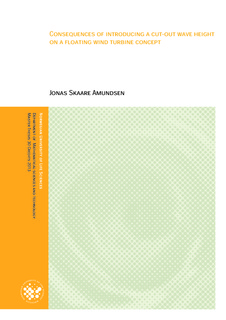Consequences of introducing a cut-out wave height on a floating wind turbine concept
Master thesis
Permanent lenke
http://hdl.handle.net/11250/188991Utgivelsesdato
2013-08-27Metadata
Vis full innførselSamlinger
- Master's theses (RealTek) [1722]
Sammendrag
This master's thesis has investigated the consequences of implementing a survival mode
system on the
oating wind turbine concept Tension-Leg-Buoy (TLB) which shuts down the
turbine at the cut-out wave height Hs;cut-out. The purpose of this is to reduce loads on the
turbine structure at extreme wave conditions. One possible system is to move the top mooring
lines upwards to the root of the nacelle, which has the potential of reducing loads in both
mooring lines and anchors. If this is achieved, the excess buoyancy can be reduced by making
the
oater smaller which again reduces the material cost of the turbine.
The downside of such a system is that the some of the annual energy production from the
wind turbine or wind farm will be lost since the turbine does not produce power in survival
mode. This leads to a yearly income loss which in total must be lower than the cost reduction
obtained from using less materials in the turbine components, in order for the system to
reduce the total cost of energy delivered by the turbine.
By using time series of meteorological data sets containing wind speed and signi cant wave
height from measurement stations in the North and Norwegian Sea, the energy loss at
di erent values of Hs;cut-out for all the sites has been found. If an energy loss of below 1% is
accepted, the optimal cut-out wave height for the various sites obtains a value of between 8
and 9 metres (signi cant wave height). Scaling of the wave data has shown that Hs;cut-out
could be lower for milder wave climates. Additionally, three di erent control strategies for the
survival mode system have been developed. The simulations using these strategies indicate
that a strategy combining measurements and wave forecasts has the best overall performance,
but these results rely on relatively high accuracy in the forecasting of wave heights.
Load simulations on the TLB have shown that there are still many challenges left to solve
with the survival mode system using recon guration of mooring lines. There was no clear
trend that the system is capable of reducing overall loads, which prevents any reduction in the
mass of the
oater. Nevertheless, the ndings regarding energy loss and control strategies,
which has the been the main focus of this thesis, will anyhow be valid for any survival mode
system. These results may be used further even though the current concept does not achieve
the load reductions required to bring down the material cost of the turbine.
